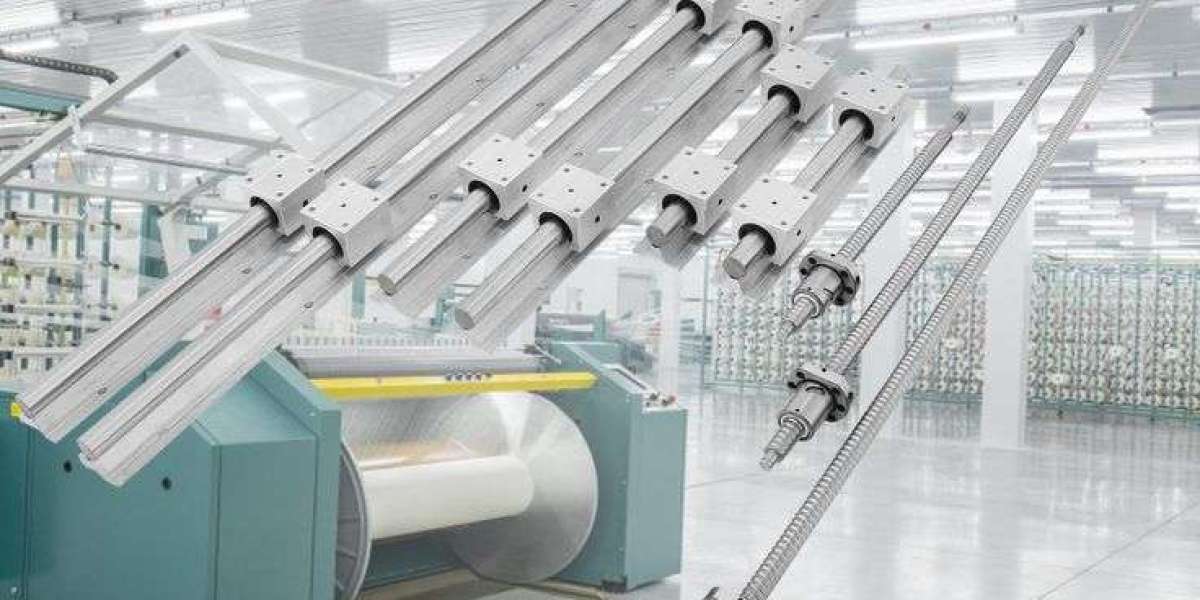What Is a Linear Carriage?
A linear carriage is the mobile component of a linear motion system, designed to attach to a load (such as a tool, workpiece, or robotic arm) and move along a fixed linear guide rail. Its primary function is to convert applied forces (mechanical, pneumatic, or electromagnetic) into smooth, linear displacement while maintaining precise alignment and load-bearing capacity. The carriage houses rolling elements (typically steel balls or cylindrical rollers) or, in some cases, sliding mechanisms (e.g., in air or magnetic bearings), which interact with raceways (grooves) on the rail to reduce friction and ensure stable motion.
Key characteristics of linear carriages include:
Precision: Tolerances as tight as ±0.001 mm, enabling micron-level accuracy for tasks like CNC machining or optical alignment.
Load Capacity: Designed to handle radial (side), axial (thrust), and moment (torque) loads, with capacities ranging from a few hundred newtons to over 200,000N for heavy-duty applications.
Stability: Resists deflection or vibration under dynamic loads (e.g., rapid acceleration or deceleration), ensuring consistent performance.
Versatility: Available in various sizes, configurations (single-axis, multi-axis), and materials (e.g., stainless steel for corrosion resistance) to suit diverse environments.
How Linear Carriages Work: The Mechanics
The operation of a linear carriage is a blend of mechanical engineering and precision design:
Integration with the Rail: The carriage is paired with a linear guide rail—a precision-machined metal (typically steel or hardened alloy) track with accurately ground raceways. The rail remains fixed to a machine frame or base, while the carriage moves along it.
Load Transfer: When a force is applied (e.g., via a motor, actuator, or manual push), the carriage’s rolling elements (balls or rollers) roll along the rail’s raceways, converting the input force into linear motion. The raceways are engineered to distribute loads evenly across multiple contact points, minimizing stress concentrations.
Recirculation Mechanism (for Rolling Elements): In most linear carriages, the rolling elements are arranged in a loop within the carriage body. As the carriage moves, the balls or rollers circulate continuously through internal channels, ensuring uninterrupted motion along the entire rail length. This design eliminates the need for external recirculation paths and enhances efficiency.
Precision Control: Tight tolerances between the carriage and rail (often ±0.001 mm or better) minimize play (backlash)—unwanted movement or looseness that can degrade accuracy. Preloaded carriages (where rolling elements are slightly compressed) further reduce play, ensuring rigid positioning.
Types of Linear Carriages: Matching Form to Function
Linear carriages come in various configurations to address specific application needs. The choice depends on factors like load capacity, speed, precision, and environmental conditions.
Ball Guide Carriages (Recirculating Balls)
Design: Steel balls roll in recirculating channels within the carriage, guided by hardened raceways in the rail.
Advantages: Balanced performance, cost-effective, and widely available.
Load Capacity: Medium to high (up to 100,000N).
Precision: Good (±0.001–0.01 mm).
Best For: CNC machines, 3D printers, general automation, and light-to-medium industrial equipment.
Roller Guide Carriages (Cylindrical Rollers)
Design: Cylindrical rollers replace balls, offering larger contact areas for higher load distribution.
Advantages: Superior load capacity and rigidity.
Load Capacity: Very high (up to 200,000N+).
Precision: Excellent (±0.0005 mm).
Best For: Heavy-duty machinery (e.g., presses, stamping equipment), large CNC routers, and industrial automation.
Crossed Roller Carriages
Design: Alternating rollers oriented at 90° angles eliminate play and maximize rigidity.
Advantages: Zero clearance, exceptional accuracy.
Load Capacity: Medium (up to 15,000N).
Precision: Outstanding (±0.00005 mm).
Best For: Semiconductor manufacturing, optical alignment, metrology, and high-precision scientific instruments.
Miniature Linear Carriages
Design: Compact versions of ball or roller carriages for small-scale applications.
Advantages: Ideal for confined spaces and precision instruments.
Load Capacity: Low to medium (up to 1,000N).
Precision: High (±0.0001 mm).
Best For: Medical devices, electronics assembly, and micro-manufacturing.
Profiled Rail Carriages (High-Precision)
Design: Combines a precision-ground steel rail with a carriage containing multiple rows of recirculating balls or rollers.
Advantages: Extremely high precision (±0.001–0.005 mm) and rigidity.
Load Capacity: High (up to 150,000N).
Best For: High-end CNC machines and precision measurement tools.
Applications Across Industries
Linear carriages are ubiquitous in industries that demand precision and reliability:
CNC Machining & Manufacturing: Guide the X, Y, and Z axes of mills, lathes, and routers for precise tool movement.
3D Printing & Additive Manufacturing: Enable smooth motion of the print head and build platform for consistent layer deposition.
Robotics & Automation: Power the linear motion of robotic arms, pick-and-place machines, and conveyor systems.
Medical Equipment: Support diagnostic devices, surgical robots, and laboratory automation systems.
Aerospace & Defense: Align satellite components, precision instrumentation, and weapon systems.
Advantages of Linear Carriages
Micron-Level Precision: Achieves tolerances as tight as ±0.001 mm, ensuring exact positioning.
High Load Capacity: Supports heavy loads (up to 200,000N) without compromising stability.
Low Friction & Smooth Motion: Reduces energy consumption and extends component life.
Rigidity & Stability: Maintains alignment under dynamic loads (e.g., acceleration or vibration).
Versatility: Available in various sizes, materials (e.g., stainless steel for corrosion resistance), and configurations.
Selection Criteria: Choosing the Right Linear Carriage
When selecting a linear carriage, engineers consider:
Load Requirements: Static and dynamic forces (radial, axial, or combined).
Precision Needs: Micron-level accuracy? Choose high-precision carriages.
Speed & Travel Distance: Higher speeds or longer strokes may require optimized rail designs.
Environment: Harsh conditions (dust, moisture, chemicals) may necessitate sealed or corrosion-resistant carriages.
Budget: Balance performance with cost, especially for high-volume applications.
Maintenance and Longevity
To maximize lifespan:
Lubrication: Regularly apply grease or oil (depending on speed and load).
Alignment: Ensure the rail and carriage are perfectly parallel during installation.
Cleaning: Keep the rail and rolling elements free of dust and debris.
Inspection: Check for wear, play, or misalignment during routine maintenance.
The Future of Linear Carriages
Advancements in materials (e.g., carbon fiber composites for lightweight carriages) and smart technologies (e.g., sensors for real-time wear monitoring) are pushing the boundaries of what linear carriages can achieve. Future systems may integrate self-lubricating coatings, predictive maintenance algorithms, and nano-engineered surfaces to further enhance performance.
Conclusion
Linear carriages are the precision-driven components of modern linear motion systems, enabling the smooth, stable, and accurate movement that powers everything from consumer electronics to aerospace technologies. By understanding their types, functions, and applications, engineers and manufacturers can select the right carriages to optimize their equipment’s performance. Whether you’re building a next-generation CNC machine or upgrading an existing system, the right linear carriage is the key to unlocking precision and efficiency.








